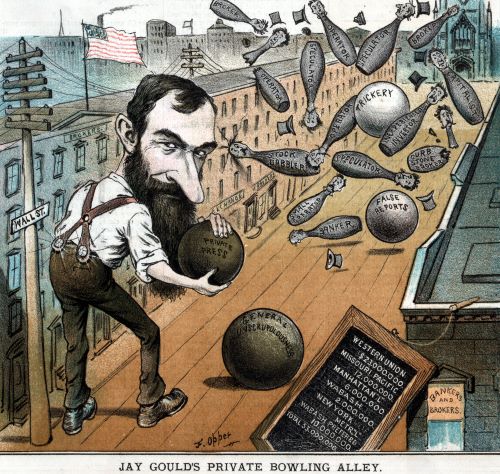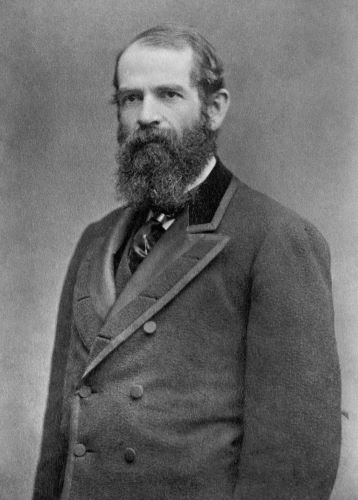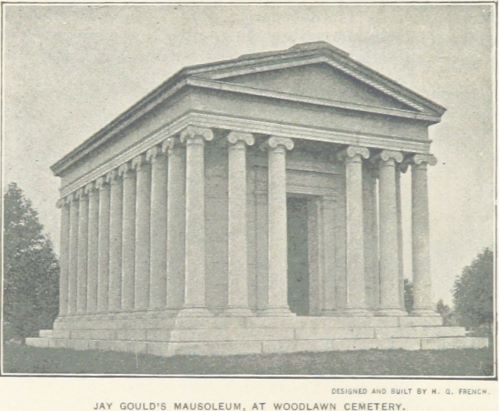

Gould accumulated vast wealth and power through a series of exploitative practices.

By Matthew A. McIntosh
Public Historian
Brewminate
Introduction
Jay Gould, one of the most controversial figures in American economic history, rose to prominence in the 19th century as a financier and railroad magnate. Known as a quintessential “robber baron,” Gould accumulated vast wealth and power through a series of exploitative practices that often devastated his competitors, workers, and the communities affected by his ventures. His manipulative and ruthless business tactics, including stock manipulation, corporate raiding, and the exploitation of labor, serve as a poignant example of the dark side of capitalist expansion during the Gilded Age. This essay will explore the ways in which Gould’s wealth was built through the exploitation of others and how his legacy continues to shape the American business landscape.
The Rise of Jay Gould: Opportunism and Manipulation
Jay Gould was born in 1836 in Roxbury, New York, into a relatively modest family. Unlike many of his contemporaries, who inherited wealth, Gould’s rise to power was self-made, albeit through highly controversial means. He first made his mark in the railroad industry, where he would later become one of the most influential figures. His early ventures were in the telegraph business, but it was his acquisition of railroads that cemented his status as a “robber baron.”
One of Gould’s most infamous actions was his manipulation of the Erie Railroad in the 1860s. In 1868, Gould and his associates began buying up stock in the Erie Railroad, eventually gaining control over the company. Gould’s approach to acquiring stock was ruthless, involving illegal practices such as stock watering, a form of stock manipulation in which the number of shares in a company was artificially inflated beyond the company’s actual value. By inflating the value of the Erie Railroad, Gould and his partners were able to sell shares at a profit, effectively swindling investors and creating a paper empire based on exaggerated value.
Gould’s actions prompted a backlash from both investors and government officials. His manipulation of the Erie Railroad stock, along with his involvement in insider trading and other dubious financial practices, earned him a reputation as one of the most unscrupulous businessmen of his time. However, despite these controversies, Gould continued to acquire more railroads and expand his wealth, further solidifying his place as a key player in the American industrial economy.
The Exploitation of Labor

While Gould’s stock market manipulation and corporate raiding garnered significant attention, his exploitation of labor was arguably just as pernicious. During the rapid expansion of the railroad network, Gould relied heavily on cheap, often exploitative labor to fuel his ventures. He was known to use immigrant workers, particularly Chinese laborers, who were paid very low wages and worked under dangerous conditions. This exploitation was not limited to immigrant workers; he also employed tactics that undermined the rights of railroad employees and minimized the cost of labor through harsh labor practices.
One of the most telling examples of Gould’s exploitation of workers was his treatment of railroad employees in the Western Union Telegraph Company, a business he had a significant stake in. In 1874, Gould was heavily criticized for lowering wages and increasing the hours of employees, pushing them to work long, grueling shifts with little regard for their welfare. His complete disregard for the working class—coupled with his unrelenting desire to increase profits—was emblematic of the broader issues facing labor during the Gilded Age. Gould’s pursuit of wealth at the expense of workers was typical of the era’s industrial elites, who prioritized profits over the well-being of their employees.
Moreover, Gould’s control over the Union Pacific Railroad provided him with a significant amount of leverage over the labor force. Workers on the railroad were subjected to long hours, dangerous working conditions, and very low wages. Gould, in turn, was able to increase his wealth by keeping operational costs low, which meant denying his employees any meaningful wage increases or improvements in their working conditions. His ability to use cheap labor as a means to amass wealth contributed to his growing fortune but simultaneously exacerbated the exploitation of American workers during the era.
The “Robber Baron” Image: Corporate Raiding and Exploitative Tactics

Jay Gould’s wealth was not only a product of railroad ownership and stock manipulation but also through his corporate raiding activities. Corporate raiding involved acquiring control over businesses by purchasing significant portions of stock, often in hostile takeovers, and then forcing restructuring or asset stripping. Gould was notorious for using this strategy to expand his empire. He used his wealth and financial influence to acquire failing railroads, banks, and telegraph companies, using them as tools to increase his own control over the market.
Gould’s manipulation of the stock market is perhaps most visible in his involvement with the Missouri Pacific Railroad, which he acquired through an aggressive stock-buying campaign. This takeover was marked by deceit and unethical practices, including the bribery of public officials to ensure his control. Gould’s financial acumen enabled him to manipulate the system to his advantage, but it also led to the exploitation of small investors who were often left holding worthless shares after his raids.
His exploits also included attempts to manipulate gold prices. Gould’s involvement in the Black Friday Scandal of 1869 demonstrated his willingness to engage in market manipulation to increase his wealth. By attempting to corner the gold market, Gould caused a financial panic that destabilized the economy. While he profited from his actions, the broader consequences were disastrous for other investors and the general public, who were left to bear the financial burden of his manipulations.
Legacy and Impact on American Business

Jay Gould’s legacy is one of unrelenting pursuit of wealth, often at the expense of others. While he contributed significantly to the expansion of the American railroad network and the growth of the telegraph industry, his methods of accumulating wealth were marked by unethical and exploitative practices. Gould’s story is a prime example of the power dynamics that shaped the Gilded Age, where a small group of wealthy individuals controlled the economy through manipulation, exploitation, and monopolistic practices.
His legacy as a “robber baron” continues to be debated by historians and economists. While some argue that his business acumen helped build the infrastructure necessary for America’s industrial growth, others emphasize the damage he inflicted on workers, investors, and the economy as a whole. Gould’s approach to business—the aggressive expansion of wealth through corporate raiding, stock manipulation, and labor exploitation—served as a model for other wealthy elites of his time and contributed to the economic inequality that characterized the Gilded Age.
In many ways, Gould’s legacy set the stage for the rise of corporate capitalism in the 20th century, a system in which the wealthy few continue to exert significant control over the economy. His actions forced the government to reconsider the role of regulation in business and eventually led to the creation of antitrust laws aimed at curbing the influence of monopolies and protecting workers.
Conclusion
Jay Gould’s wealth was built on the suffering and exploitation of countless individuals. From his manipulation of the stock market to his exploitation of workers, Gould’s business practices were a clear demonstration of how wealth was often accumulated at the expense of the common person during the Gilded Age. While his actions may have been legal in their time, they were deeply unethical and often harmful to the broader public. His legacy serves as a cautionary tale about the dangers of unchecked capitalism and the ways in which wealth and power can be concentrated in the hands of a few at the expense of the many.
Appendix
Endnotes
- Ron Chernow, Titan: The Life of John D. Rockefeller, Sr. (New York: Random House, 1998), 125.
- Richard Hofstadter, The Age of Reform: From Bryan to FDR (New York: Vintage Books, 1955), 101.
- Gabriel Kolko, The Triumph of Conservatism: A Reinterpretation of American History, 1900–1916 (Chicago: The Free Press, 1963), 88.
- Nelson Lichtenstein, State of the Union: A Century of American Labor (Princeton: Princeton University Press, 2002), 43.
Bibliography
- Chernow, Ron. Titan: The Life of John D. Rockefeller, Sr. New York: Random House, 1998.
- Hofstadter, Richard. The Age of Reform: From Bryan to FDR. New York: Vintage Books, 1955.
- Kolko, Gabriel. The Triumph of Conservatism: A Reinterpretation of American History, 1900–1916. Chicago: The Free Press, 1963.
- Lichtenstein, Nelson. State of the Union: A Century of American Labor. Princeton: Princeton University Press, 2002.
Originally published by Brewminate, 07.07.2025, under the terms of a Creative Commons Attribution-NonCommercial-NoDerivatives 4.0 International license.


